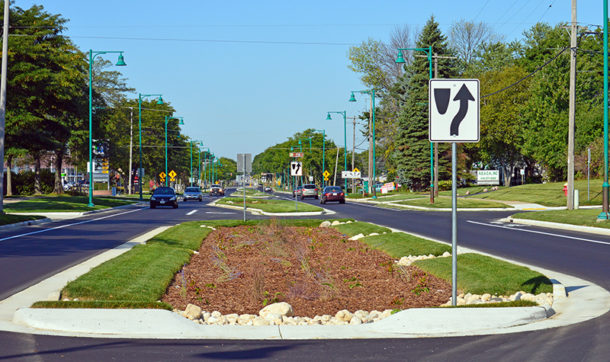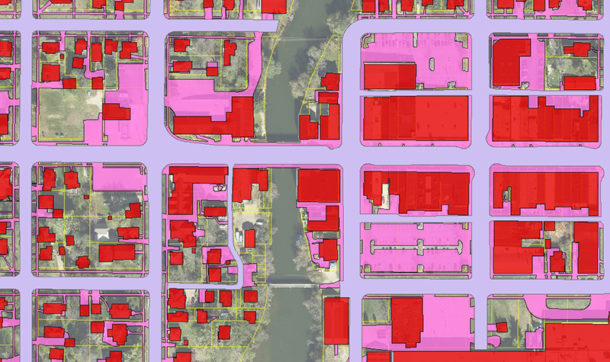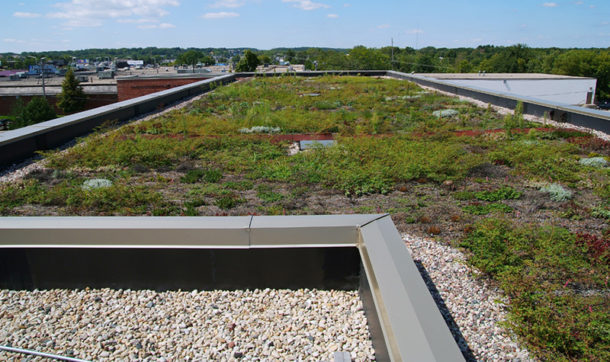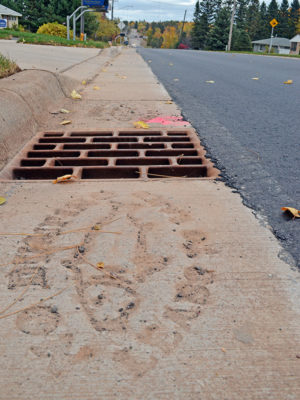Best Management Practices Clean, Control Stormwater
 Most communities have a substantial investment in a system that historically has been nearly invisible: the system of drains and pipes that diverts stormwater and snow melt from streets, sidewalks, and parking lots. If it’s working correctly, the system does its job, water disappears, and people go on with their day.
Most communities have a substantial investment in a system that historically has been nearly invisible: the system of drains and pipes that diverts stormwater and snow melt from streets, sidewalks, and parking lots. If it’s working correctly, the system does its job, water disappears, and people go on with their day.
It’s a natural system in undeveloped areas. Rain and melting snow dissipate into the ground, evaporate, or find a path to rivers and lakes. Along the way, pollutants have a chance to filter out, protecting our waterways and groundwater.
That’s not the case in developed areas, where as much as 60 percent of the surface area will be covered by streets, sidewalks, and buildings. These impervious surfaces prevent the natural dispersal of water; rain and snow melt cannot enter the ground. The stormwater management system collects runoff and carries it away.
 The invisible system becomes very visible indeed when it’s overwhelmed by water from storms or rapid snow melt. And unfortunately, there’s little chance for the pollutants to filter out with the traditional stormwater management system: What goes down the drain goes into the lake, river, or – potentially – the groundwater. Putting in more drains and more pipe isn’t necessarily the way to expand the system’s effectiveness.
The invisible system becomes very visible indeed when it’s overwhelmed by water from storms or rapid snow melt. And unfortunately, there’s little chance for the pollutants to filter out with the traditional stormwater management system: What goes down the drain goes into the lake, river, or – potentially – the groundwater. Putting in more drains and more pipe isn’t necessarily the way to expand the system’s effectiveness.
How Can Green Infrastructure Affect Stormwater?
To help communities improve stormwater management, the Environmental Protection Agency (EPA) in recent years has focused on “green infrastructure,” ways of incorporating green space into street and parking lot development that will soak up and store runoff. Increasingly, communities are turning to green infrastructure for solutions that mimic nature’s way:
- Using porous pavements that allow rain and snowmelt to pass through into the ground
- Installing rain gardens and other elements along streets and parking lots
- When doing street retrofits, crowning the surface to channel runoff toward a median bioretention area
- Grading street slopes to one side to channel runoff into bioretention features on one side of the road

How Can Developers Improve Stormwater Management?
Many communities now require developers to include natural stormwater management features into new building projects. Incorporating landscaped bioswales or rain gardens/planter boxes in a development’s streetscape can improve the management of runoff – and also provide visual appeal.
How Can Residents Help Protect Stormwater?
One of the least expensive and potentially most effective ways of maximizing the system is helping residents understand their role in stormwater management:
- Let people know where the system drains. Most will be more careful with waste oil, lawn chemicals, and similar products if they can envision the pollutants entering their river, lake, or drinking water supply.
- Encourage landscaping that helps give rainwater and snowmelt a place to go. Every green space helps.
- Provide rain barrels at low cost and give tips on how to manage and use the collected rainwater.
- Start a “disconnect the downspout” campaign to encourage property owners to divert downspouts from the municipal stormwater system to rain barrels, swales, or other means of storing runoff.
- Ask residents to help keep street gutters and drains clear, or to report problem areas.
 Making the stormwater management system more visible could help to make it more effective, as community residents become aware of their role in helping municipalities make the most of the existing infrastructure. And if a community is looking to do major stormwater improvements and needs a way to fairly assess fees to property owners to pay for it, a solid first step is to use aerial mapping to determine the impervious area on each property. We’re working with Libertyville, Illinois, to crunch runoff-related numbers for every property in the village.
Making the stormwater management system more visible could help to make it more effective, as community residents become aware of their role in helping municipalities make the most of the existing infrastructure. And if a community is looking to do major stormwater improvements and needs a way to fairly assess fees to property owners to pay for it, a solid first step is to use aerial mapping to determine the impervious area on each property. We’re working with Libertyville, Illinois, to crunch runoff-related numbers for every property in the village.
Moving forward, efforts to mimic nature’s ways of collecting and treating stormwater can help maximize existing infrastructure. Adding green spaces, swales, and other ways of managing water from storm events and snow melt can also serve to make a community more attractive. That’s one way of turning that traditionally invisible system into a welcome addition to the community.
Ayres Associates’ civil engineers routinely incorporate stormwater management systems into their designs as well as provide stormwater master planning, erosion control plans, and more stormwater-related services.

Post a comment: